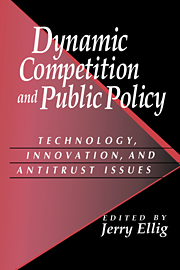Book contents
- Frontmatter
- Contents
- List of Figures and Tables
- Acknowledgments
- List of Contributors
- Introduction
- 1 A Taxonomy of Dynamic Competition Theories
- 2 Competence Explanations of Economic Profits in Strategic Management: Some Policy Implications
- 3 Innovation and Antitrust Enforcement
- 4 New Indicia for Antitrust Analysis in Markets Experiencing Rapid Innovation
- 5 Innovation and Monopoly Leveraging
- 6 Network Effects and the Microsoft Case
- 7 Technological Standards, Innovation, and Essential Facilities: Toward a Schumpeterian Post-Chicago Approach
- 8 Intellectual Property and Antitrust Limitations on Contract
- 9 Conclusion
- Index
5 - Innovation and Monopoly Leveraging
Published online by Cambridge University Press: 05 June 2012
- Frontmatter
- Contents
- List of Figures and Tables
- Acknowledgments
- List of Contributors
- Introduction
- 1 A Taxonomy of Dynamic Competition Theories
- 2 Competence Explanations of Economic Profits in Strategic Management: Some Policy Implications
- 3 Innovation and Antitrust Enforcement
- 4 New Indicia for Antitrust Analysis in Markets Experiencing Rapid Innovation
- 5 Innovation and Monopoly Leveraging
- 6 Network Effects and the Microsoft Case
- 7 Technological Standards, Innovation, and Essential Facilities: Toward a Schumpeterian Post-Chicago Approach
- 8 Intellectual Property and Antitrust Limitations on Contract
- 9 Conclusion
- Index
Summary
The concept of monopoly leveraging – the idea that a firm with monopoly in one market can use its power to gain monopoly power in another – is an old and persistent one. And why not? The picture of the ever expanding empire of a “male factor of great wealth” has at least the appeal of a well-told horror story. In the past few decades, however, economists and others have cast doubt on the realism of the tale, and the current state of thinking is that profitable monopoly leveraging is possible, but not so often as might be supposed without analysis.
In some industries, the presence of technical innovation lends a new dimension to the story. Innovations can provide the ability to leverage or can threaten a monopolist who does not leverage. Moreover, where leveraging involves innovation, the analyst and the antitrust authorities are presented with the problem of deciding whether the benefits to consumers of the innovation itself outweigh the anticompetitive effects of leveraging. Indeed, they may be presented with the problem that the leveraging monopolist seeks to disguise its actions as socially beneficial innovation precisely to evade antitrust sanctions.
In this chapter, I discuss (relatively informally) three antitrust cases in which I have been involved and which, in one way or another, illustrate these issues. These are: the computer reservations systems (CRS) cases, the IBM antitrust case of the 1970s, and the recent Microsoft case.
- Type
- Chapter
- Information
- Dynamic Competition and Public PolicyTechnology, Innovation, and Antitrust Issues, pp. 138 - 159Publisher: Cambridge University PressPrint publication year: 2001
- 3
- Cited by



